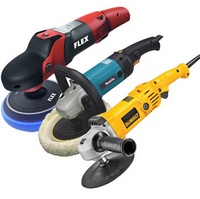High Speed Buffers
Helping you ask the right questions!

High speed buffers are considered the red-headed step children of the car polishing and detailing world. Unfortunately the wrong people seem to carry the loudest voice when it comes to popular opinions. The online forums are filled with wannabe detailers and so called experts spreading opinions based on limited experience.
And if that wasn't enough, you add further confusion by many other people simply regurgitating bad and unverified information. Anyone looking to take their polishing skills and performance to the next level must seriously consider what the industry has to offer in the way of high-speed polishers.
"My experience has shown that most people don't have enough information to even ask the right questions."
high speed buffers:
Asking the right questions
Often we find ourselves making decisions based on partial information; largely because we are all now drowning in this digital sea of free information called the Internet. The Internet now allows virtually anyone a free platform in which to express their opinion, regardless of whether this opinion is good, bad, or even based in any degree of actual experience.
With that said, let me lay out the questions I think you should be asking yourself:
- What is a high-speed buffer?
- What are the different types of buffers?
- How would I know which buffer is the right one for me?
- What buffer do you use?
- Which buffer would you recommend most?
What is a high-speed buffer:
- High speed buffers are the same thing as rotary buffers. (they spin on a single axis point)
- "Polishers" and "buffers" are the same. They are interchangeable terms.
What are the different types of buffers:
Rotary Polishers:
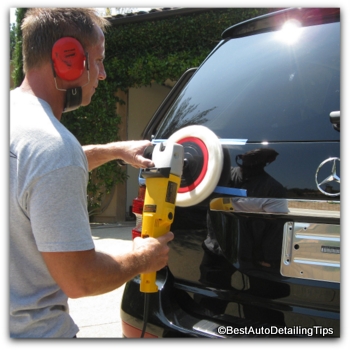
- Also called high speed buffers.
- The polishing head spins on a single axis point.
- Considered the "devil" among the different types of car polishers due to endless stories of paint damage, burned edges, or swirl marks.
- Is only the "devil" if put into the wrong hands of an inexperienced person.
- Capable of producing great friction, speed, and heat that is necessary for certain types of polishing, or when polishing certain types of material eg. car paint, gel coat, metal, etc.
- The buffer you turn to when you want to do the heavy lifting when it comes to polishing, paint correction, restoration, etc.
- Can also be used to finish paint to perfection when used by a skilled person.
- The buffer used almost exclusively by the body shop industry. (an industry where speed is the top priority, rather than perfection)
- Due to
the introduction of the other types of car buffers, very few detailers
or enthusiasts use, or learn to use a rotary with true craftsman level
skills.
- The only buffer that will prove effective on certain types of polishing or compounding. (due to its ability to spin at higher speeds and produce greater levels of friction and heat)
Random Orbital Buffers:
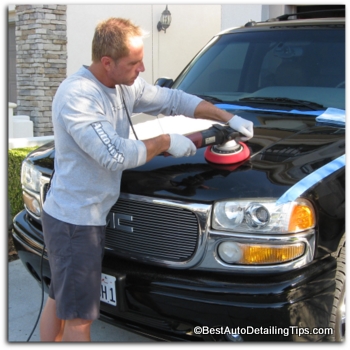
- Also called dual-action, or DA polishers.
- These buffers have (2) points of rotation or movements.
- They both spin and oscillate (vibrate).
- Considered the safest choice in choosing a car buffer due to its "random" rotation/spinning.
- Think of it like this: The earth spins on a single axis point, while rotating around the sun.
- The
reason these types of car polishers are so safe is that when too much,
or enough pressure is put upon the polisher, the polishing head stops
spinning and only remains "vibrating" or oscillating at that point. This
is like a safety feature that prevents excessive heat/friction build-up
by inexperienced people.
- The very reason these polishers are so safe, is the very reason of their biggest limitation. (as a skilled detailer, you don't necessarily want the polishing head to ever stop spinning and oscillating. Essentially you give up a certain level of control as you are limited by the machine)
- The best place to start if you are a true beginner in virtually everyone's opinion. And this includes me! If you are a true beginner and you want a very simplified approach to car polishing, I recommend you go to "Car Polishing for Beginners" and see exactly the route I recommend.
- The "go-to" car polisher for what many people refer to as a swirl free finish. (no holograms)
Positive Drive Orbital Polisher:
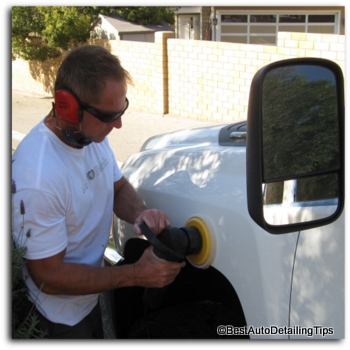
- Also a dual-action polisher.
- Different than the random orbital in that both the spinning and oscillating (vibrating) are gear driven.
- Regardless of pressure you put onto the machine while polishing, both the spinning and oscillating will remain constant.
- Because these polishers are gear driven and not "random", they will prove to be a bit harder to control, or use when polishing.
- Some people will consider a positive drive dual action polisher as "less" safe than a true random orbital.
- The positive drive action also means you remain in more control when polishing since you will not be limited by the machine itself.
- Considered by many professional detailers as the best choice in a car buffer as you get the benefits of being in control, without the dangers associated with the high speed buffers.
- Because even a positive drive orbital buffer cannot produce the same level of friction and heat of a rotary, you will be limited to the type of work you can do, or how fast you can get to the finished result.
- The "go-to" car polisher to produce what many call a swirl free, or hologram free finish.
how do you decide which buffer is the right one for you:
The big question of the moment!!
Let me see if I can reduce this down to an incredibly simple answer for you:
"A Random Orbital Car Polisher"
Which you can see which car polisher and polishing kit I recommend by going to "Car Polishing for Beginners"
Darren's Professional Tips:
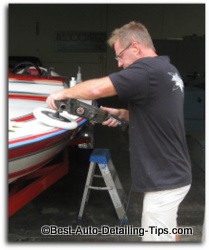
Let's do a review of what we have learned:
- High speed buffers have developed a bad reputation due to improper training of guys using them, which then in turn delivers endless stories of mistakes and problems. (It is the person using the high speed buffer, not the buffer itself)
- The newer models start at a very low 600 RPM speed and are as safe as any orbital buffer. (most beginners do not realize the huge difference this makes in terms of the initial learning curve)
- Now a greater range of jobs and users can enjoy these quality built machines. (due to the very low operating speed these high speed polishers can be set, any beginner can safely and confidently "ease" their way towards mad skills!)
- Any of the buffers from this page would make my list of top picks for car polishers. (that link will take you to my boat polisher page, but it has all my top picks for the high speed polishers I recommend)
- I recommend orbital car polishers to any beginner as a rule.
- As a professional growing up using nothing but the high speed buffer, I know I can do the heavy lifting far quicker with a rotary polisher, then switch to a DA (dual action) random car polisher if I prefer for hologram removal.
- Because of my experience, I can also do the heavy lifting of compounding, then dial down the operating speed of the high speed polisher, switch from a wool pad to a foam pad, and finish the paint to a swirl free, hologram free finish.
- So in a perfect world, you might come to the conclusion that you will eventually want both a high speed polisher, and a quality random orbital (DA buffer). But since it's not a perfect world and you are trying to decide; I say the random orbital dual-action polisher is the go-to choice for most guys.
I hope this has helped!
Sincerely,

- Home Page ›
- Car Polish ››
- This Page
|
|
